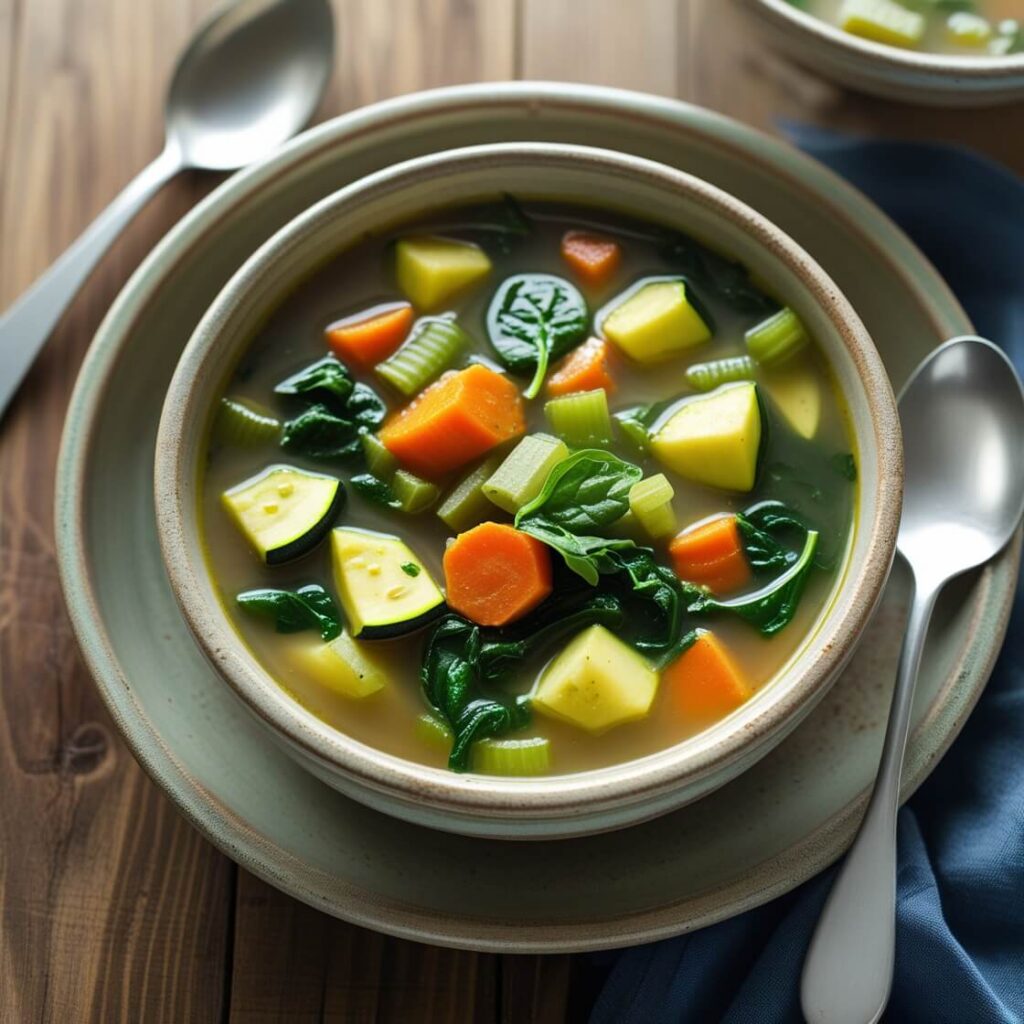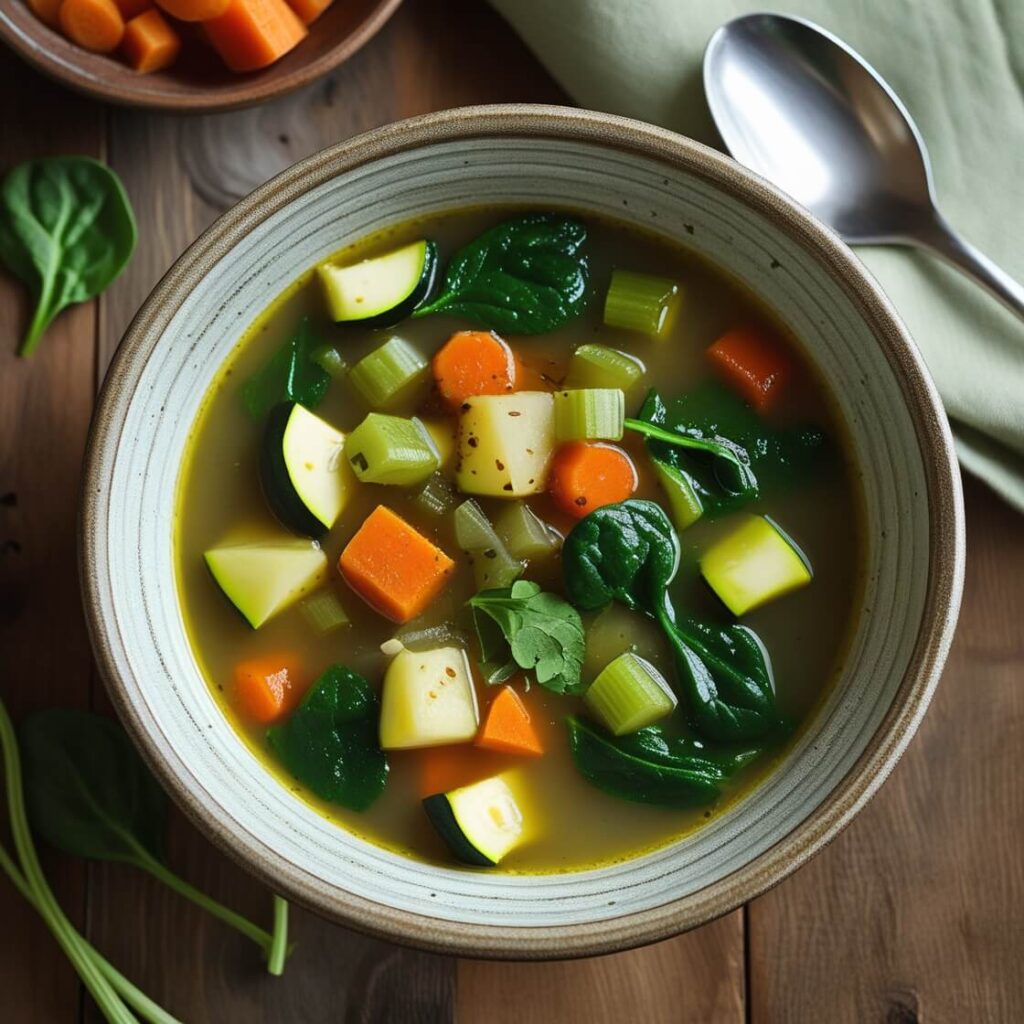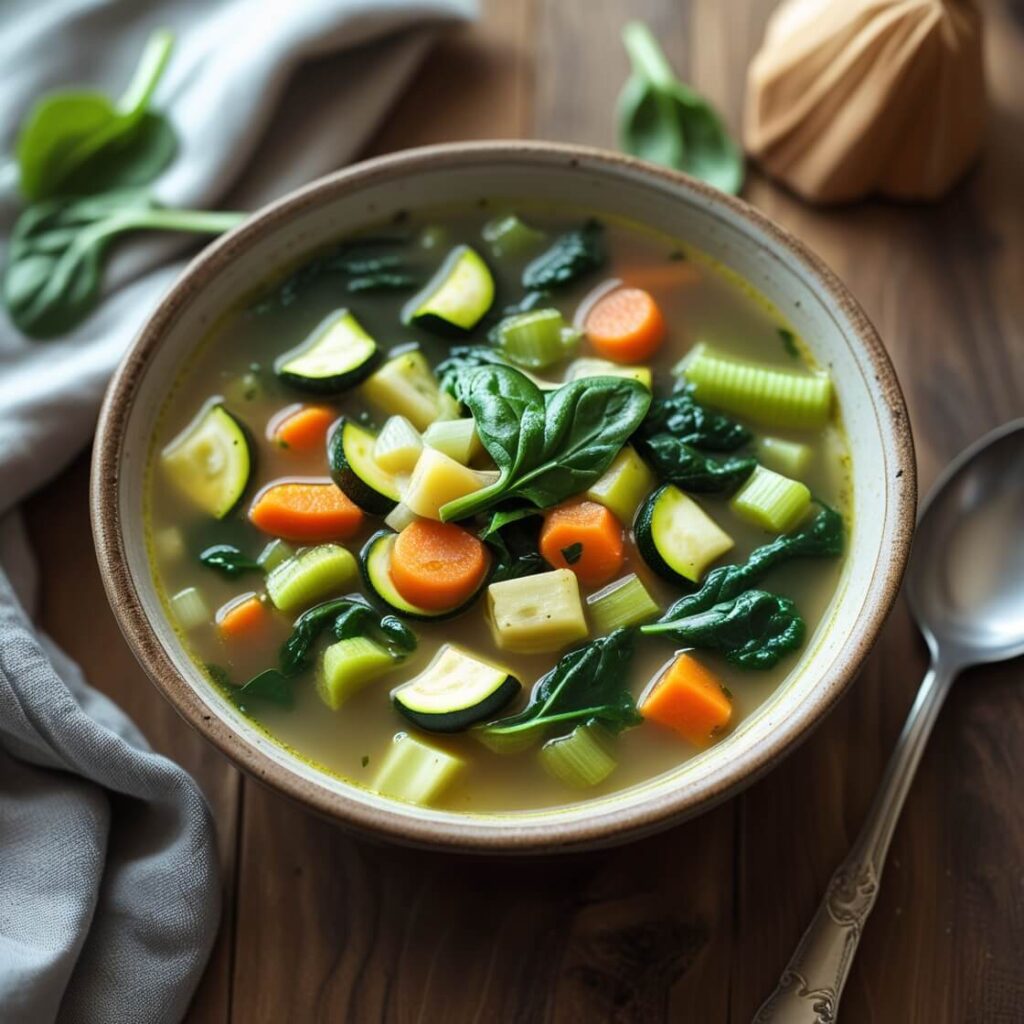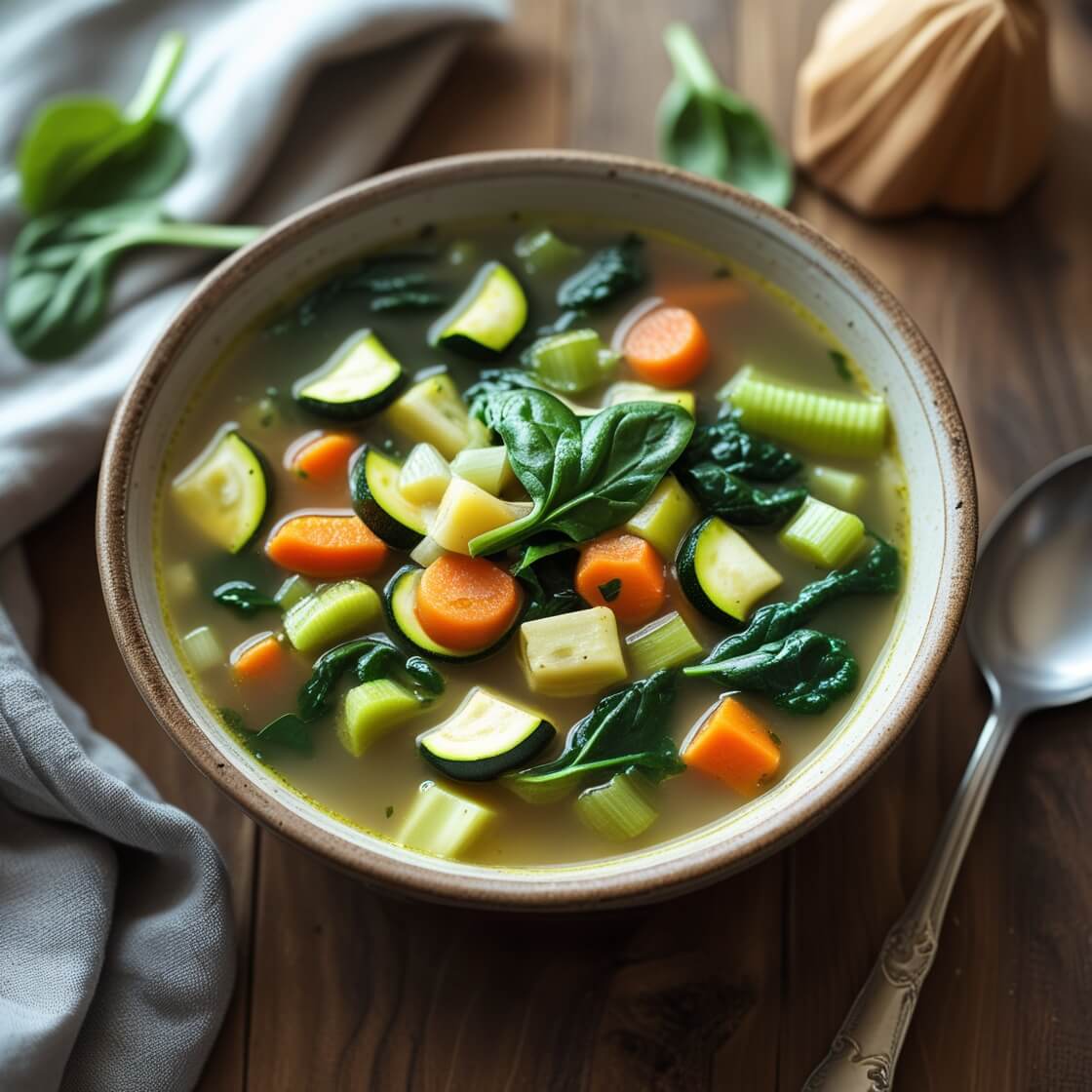Diabetic friendly soups offer a delicious solution for managing blood sugar while still enjoying comforting meals. As someone who understands the challenges of balancing taste with health needs, I’ve discovered that these nutrient-rich soups can be both satisfying and beneficial for those following a diabetes-friendly eating pattern.
In fact, the soups we’ll explore today contain less than 20 grams of carbohydrates per serving, making them excellent options for people with diabetes who are monitoring their carb intake. From Zuppa Toscana with Cauliflower and Kale at just 6g of carbs to Tomato Basil Bisque with 10g of carbs, these recipes prove that flavor doesn’t have to be sacrificed for health.
Whether you’re looking for a simple snack, a filling mid-week meal, or a dish to serve your family, these diabetic friendly soups offer endless variations. Additionally, with the right ingredients, they can be particularly helpful if you’re trying to maintain a healthy weight while managing your blood sugar levels. In this guide, I’ll share my favorite recipes and expert tips to help you create delicious, blood-sugar smart comfort food that you’ll genuinely enjoy.
Top Benefits of Diabetic Friendly Soups
The remarkable benefits of diabetic friendly soups extend far beyond basic nutrition. These warming bowls offer meaningful advantages for anyone monitoring their blood sugar levels.

Diabetic Friendly Soups – Warm, healthy, and satisfying!
Low in carbs, high in fiber
Soups formulated for people with diabetes strike an ideal balance—low in carbohydrates yet rich in dietary fiber. Many recipes contain less than 20 grams of carbs per serving, making them perfect for those watching their carbohydrate intake. The high fiber content helps regulate blood glucose by slowing digestion and preventing rapid spikes in blood sugar levels.
Non-starchy vegetables form the foundation of these nutritious soups. Leafy greens, peppers, mushrooms, and eggplant provide essential nutrients without the carbohydrate load of starchy alternatives. For instance, Zuppa Toscana with Cauliflower contains just 6 grams of carbs, whereas Tomato Basil Bisque offers only 10 grams per serving.
Keeps you full longer
Research suggests that diabetic friendly soups can keep you fuller longer than eating the same ingredients separately, especially those containing lentils and other legumes. This satiety effect proves valuable for people trying to avoid between-meal snacking—a common challenge when managing diabetes.
The combination of protein and fiber creates a slow-digesting meal that maintains steady blood sugar levels. Studies have shown that consuming a 110-gram serving (about 1 cup) of cooked lentils reduced post-meal blood sugar by as much as 20%. Moreover, these soups are typically “less energy-dense,” meaning you can enjoy a satisfying portion without excessive calories.
Easy to batch cook and store
Practical preparation advantages make these soups even more appealing. Homemade diabetic friendly soups can last in the refrigerator for up to three days when properly stored. For longer preservation, they freeze beautifully for up to two months.
This storage flexibility transforms meal planning for diabetes management. Instead of daily food preparation struggles, you can prepare a large batch on weekends and portion it for convenient meals throughout the week. Consequently, you’ll always have a blood-sugar friendly option available when hunger strikes or time runs short.
10 Diabetic Friendly Soups You’ll Love
From hearty legumes to vegetable-packed broths, these diabetic friendly soups prove that managing blood sugar doesn’t mean sacrificing flavor. Each recipe here contains less than 20 grams of carbohydrates per serving, making them perfect additions to your meal planning arsenal.

Stay on track with these Diabetic Friendly Soups!
1. Lentil and Tomato Soup
This protein-packed soup combines red lentils with tangy tomatoes for a balanced meal that’s kind to your blood sugar. Lentils have a low glycemic index of just 32, helping prevent rapid spikes in glucose levels. The fiber content—nearly 15 grams per cup—further slows digestion and improves blood sugar management. With only 12 grams of carbs per serving, this hearty soup offers remarkable staying power.
2. Chicken and Spinach Soup with Pesto
Rich in protein yet light on carbohydrates, this vibrant soup combines lean chicken with nutrient-dense spinach. The addition of pesto brings depth without added sugars. Notably, this recipe contains just 8 grams of carbs per serving while providing essential nutrients like iron and vitamin K from the spinach.
3. Butternut Squash and Barley Soup
Despite including squash, this soup remains diabetes-friendly when properly portioned. The pearl barley adds fiber that helps moderate blood sugar impact. Furthermore, butternut squash contains compounds that may improve insulin sensitivity. This warming soup delivers approximately 15 grams of carbs per serving.
4. Turkey and Vegetable Barley Soup
Lean turkey provides protein without fat, while barley offers soluble fiber that helps regulate glucose absorption. This balanced soup makes an excellent post-workout meal as it replenishes energy without causing blood sugar spikes. Each bowl contains roughly 14 grams of carbohydrates.
5. Creamy Cauliflower Soup
This velvety soup achieves creaminess without heavy cream by using pureed cauliflower. Besides being remarkably low in carbs at just 7 grams per serving, cauliflower contains sulforaphane, which some studies suggest may help lower blood sugar levels.
6. White Bean and Kale Soup
White beans provide both protein and fiber, creating a soup that satisfies hunger while supporting stable blood sugar. The addition of kale brings vitamins A, K, and C along with additional fiber. Though slightly higher in carbs at 18 grams per serving, the fiber content helps moderate its glycemic impact.
7. Spiced Carrot and Ginger Soup
Ginger may help improve insulin sensitivity, making it an excellent addition to diabetic friendly recipes. This vibrant soup contains approximately 13 grams of carbs per serving, with carrots providing valuable beta-carotene and fiber.
8. Chicken Chili Verde
This protein-rich alternative to traditional chili uses tomatillos and green chilies instead of beans to keep carb counts manageable. Generally, a serving contains about 10 grams of carbohydrates while delivering satisfying protein and metabolism-boosting capsaicin from the chilies.
9. Zuppa Toscana with Cauliflower
Traditional Italian cuisine takes a diabetic friendly turn with this cauliflower-based Zuppa Toscana. Unlike the restaurant version that relies on potatoes, this smart adaptation swaps in cauliflower to dramatically lower the carbohydrate content while maintaining the creamy texture diabetics crave.
This clever remake of the classic Italian soup boasts an impressive 6 grams of carbohydrates per serving, making it the lowest-carb option in our collection. The combination of cauliflower, Italian sausage, and kale creates a hearty, satisfying meal without the blood sugar impact of traditional potato-based recipes.
What makes this soup work beautifully for blood sugar management is its perfect balance of protein and fiber. The Italian sausage provides savory protein that helps prevent hunger between meals, while the cauliflower and kale deliver essential fiber that slows digestion. Although the original recipe typically includes heavy cream, this version uses a moderate amount of half-and-half or cashew cream to maintain richness without excessive fat.
To prepare this soup, first brown nicely seasoned Italian sausage (choose chicken or turkey varieties for less saturated fat). Next, sauté onions and garlic until translucent, then add cauliflower florets cut to mimic potato chunks. Chicken broth forms the base, allowing the flavors to meld during simmering. Fresh kale gets stirred in during the final minutes, wilting just enough while maintaining nutritional integrity.
The resulting soup offers remarkable depth – slightly spicy from the sausage, earthy from the kale, and surprisingly creamy from the cauliflower. Each spoonful delivers comfort food satisfaction without the carbohydrate load. This makes it ideal for weekly meal prep as it reheats beautifully while maintaining its nutritional profile.
10. Tomato Basil Bisque
Another classic receives a diabetic friendly makeover in this velvety tomato basil bisque. At just 10 grams of carbs per serving, this adaptation proves you don’t need added sugars or heavy cream to create rich, satisfying flavor.
How to Make Your Own Diabetic Friendly Soup
Creating your own diabetic friendly soups at home gives you complete control over ingredients and nutrition. By following these essential guidelines, you can craft delicious soups that support blood sugar management while delivering maximum flavor.

Nutritious and delicious – perfect soups for diabetics!
Choose a low-sodium stock base
The foundation of any good soup is the stock. For people with diabetes, low-sodium versions are essential since high sodium intake is linked to increased blood pressure—a common concern with diabetes. Look for stocks with fewer than 150mg of sodium per cup. Some excellent options include:
- Swanson unsalted chicken broth (45mg per cup)
- Pacific Natural Foods low-sodium chicken broth (70mg)
- College Inn unsalted chicken stock (50mg)
You can also make your own vegetable stock in about 30 minutes, giving you complete control over sodium content. Admittedly, if you’re short on time, simply using water works too!
Add non-starchy vegetables
Non-starchy vegetables form the heart of diabetic friendly soups because they’re high in fiber yet low in carbohydrates. Focus primarily on vegetables like broccoli, spinach, kale, peppers, mushrooms, cabbage, tomatoes, and zucchini. These ingredients provide essential nutrients without significantly impacting blood sugar levels.
Remember to limit starchy options like potatoes, corn, and peas, which can raise blood glucose more rapidly. Essentially, aim to fill your soup pot with colorful, fiber-rich vegetables that add volume without adding excessive carbs.
Include lean proteins or legumes
Protein helps slow down digestion and subsequently delays glucose release into the bloodstream. Indeed, adding proteins like chicken, turkey, fish, or tofu to your soups creates more satisfying meals that keep you full longer.
Legumes such as lentils, chickpeas, and beans offer a dual benefit—they provide both protein and fiber. However, be mindful that individual responses to legumes vary; they might be excellent for some people with diabetes but problematic for others.
Use herbs and spices instead of salt
Herbs and spices add tremendous flavor while helping you reduce sodium. First, experiment with diabetes-friendly options like cinnamon, which may help improve blood sugar levels. Other excellent choices include ginger, turmeric, rosemary, thyme, and garlic.
Try adding a squeeze of fresh lemon juice or vinegar to “trick” your palate into perceiving saltiness. Remember that taste buds adjust to lower salt levels over time—usually within a couple of weeks.
Avoid cream and high-fat dairy
Traditional creamy soups often contain heavy cream or full-fat dairy that adds unwanted saturated fat and calories. Instead, create creamy textures by:
- Blending part of your vegetables (especially cauliflower) to create thickness
- Using Greek yogurt instead of cream
- Trying cashew cream or coconut milk for dairy-free alternatives
- Making a roux with vegetable oil and flour to thicken broths
Tips for Storing and Reheating Soups
Proper storage and reheating techniques preserve both the flavor and nutritional value of your diabetic friendly soups, ensuring they remain safe for consumption over time. With the right methods, you can effectively extend the shelf life of your homemade creations.

Easy Diabetic Friendly Soups to nourish your day!
How long soups last in the fridge
Typically, diabetic friendly soups remain safe in the refrigerator for up to three to four days. Before refrigerating, allow your soup to cool at room temperature for one to two hours, then cover and refrigerate until cold. This cooling process helps maintain quality and safety.
Always check for spoilage signs prior to consumption—discoloration, foul odor, or unpleasant taste indicate your soup should be discarded. Different soups have varying shelf lives: meat-based soups last up to four days, whereas seafood soups should be consumed within two days.
Freezing soups for meal prep
Freezing extends soup storage dramatically—most diabetic friendly soups can be frozen for two to three months, making batch cooking an excellent strategy for blood sugar management. Some dairy-free varieties may even last up to six months.
First, cool your soup completely (ideally overnight in the refrigerator) before transferring to the freezer. Portioning into single servings before freezing allows for convenient individual meals. Remember to leave about an inch of space at the top as soup expands during freezing.
Best containers for storage
Glass containers are often preferred for soup storage as they’re non-porous, preventing staining and odor retention. For optimal freezer storage, select containers with airtight seals that lock out moisture and prevent freezer burn.
Both glass and BPA-free plastic containers work well, provided they’re specifically labeled “freezer-safe”. Silicone containers offer additional benefits as they make frozen soup removal easier.
Reheating without losing nutrients
To maintain nutritional integrity when reheating from frozen, thaw your soup in the refrigerator one to two days before serving. For faster thawing, place the container in warm water until the soup begins to loosen.
When reheating, use medium-low heat on the stovetop to prevent burning. For microwave reheating, use 30% power for 3-5 minutes, stirring occasionally for even warming. Thoroughly heat meat-based broths to a boil for three minutes to eliminate any harmful bacteria.
Discovering the world of diabetic friendly soups opens up new possibilities for maintaining stable blood sugar levels without sacrificing taste or satisfaction. Throughout my years as a chef, I’ve witnessed firsthand how these nutrient-dense meals can transform meal planning for those managing diabetes.
What makes these soups truly valuable is their versatility. You can customize endless variations based on seasonal produce, protein preferences, and flavor profiles—all while keeping carbohydrate content in check. The recipes and techniques shared here are merely starting points for your culinary creativity.
Remember that consistency matters more than perfection. Start by incorporating one or two of these soups into your weekly rotation, gradually expanding your repertoire as you become more comfortable with the ingredients and cooking methods. Even substituting a regular soup with a diabetic friendly alternative once weekly represents meaningful progress.
Alongside regular blood glucose monitoring, these soups can form part of an effective strategy for managing diabetes through diet. Nevertheless, always consult with your healthcare provider or dietitian before making significant changes to your eating patterns, as individual needs vary considerably.
Don’t hesitate to experiment beyond these recipes. Perhaps try adding turmeric to your chicken soup for its potential anti-inflammatory properties, or incorporating small amounts of apple cider vinegar, which some research suggests may help lower post-meal blood sugar levels.
As you embark on this culinary journey, focus primarily on enjoyment rather than restriction. After all, the most effective diabetic friendly meals are those you genuinely look forward to eating. By balancing nutritional needs with flavor satisfaction, these soups can become staples in your kitchen—offering comfort, nourishment, and blood sugar support in each steaming bowl.
I hope these recipes inspire you to view diabetes-compatible cooking as an opportunity for culinary exploration rather than limitation.
About HealthyBlog365
Welcome to HealthyBlog365, your go-to destination for all things food and drink. We believe that every meal is not just a way to nourish your body but also a meaningful connection with yourself and your loved ones.
HealthyBlog365 was created with a mission to inspire healthy living through nutritious meals and refreshing beverages. Here, you’ll discover a treasure trove of creative recipes, kitchen tips, and healthy eating trends tailored to fit modern lifestyles.
 What can you find on HealthyBlog365?
What can you find on HealthyBlog365?
- Delicious and easy-to-make recipes: From simple meals for busy mornings to wholesome dinners for family gatherings, we’ve got you covered for every occasion.
- Nutritious drinks: Explore recipes for juices, smoothies, detox teas, and drinks that cleanse your body, boost your mood, and energize your day.
- Guides on eating habits: Get detailed insights into popular diets like keto, low-carb, and vegetarian-friendly meal plans.
- Kitchen hacks: Discover smart tips to save time, preserve food, and cook more efficiently.
We are committed to providing high-quality content, staying up-to-date with the latest trends, and maintaining a balance between nutrition and flavor.
 Connect with HealthyBlog365 on Social Media
Connect with HealthyBlog365 on Social Media
Join the HealthyBlog365 community on social media platforms to stay updated with our latest posts, watch exciting tutorials, and share your food stories with us:
Facebook: Follow us here to stay updated with our latest posts and join our community.
Instagram: Check us out here for inspiring visuals and ideas.
Pinterest: Pin with us here to save creative ideas you’ll love.
YouTube: Subscribe here for detailed tutorials and exciting videos.
 Thank You for Supporting HealthyBlog365!
Thank You for Supporting HealthyBlog365!
We aim to build a connected community where everyone can share and learn from each other. If you have any questions or suggestions, don’t hesitate to reach out to us via social media or our website.
We hope you have a wonderful time on HealthyBlog365 and find new inspiration for your healthy culinary journey!

